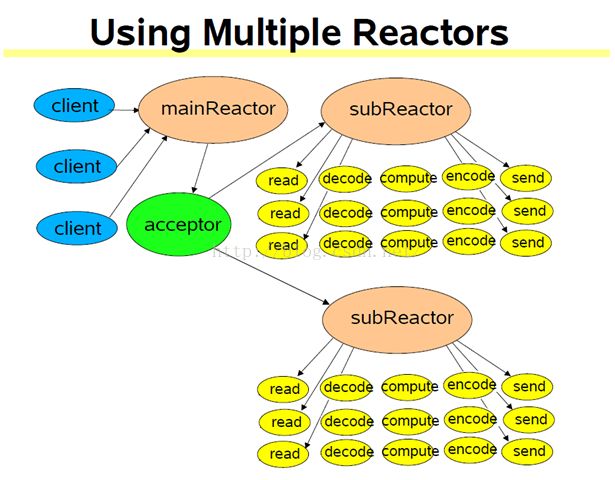Muduo网络库源码分析(四)EventLoopThread和EventLoopThreadPool的封装
muduo的并发模型为one loop per thread+ threadpool。为了方便使用,muduo封装了EventLoop和Thread为EventLoopThread,为了方便使用线程池,又把EventLoopThread封装为EventLoopThreadPool。所以这篇博文并没有涉及到新鲜的技术,但是也有一些封装和逻辑方面的注意点需要我们去分析和理解。
EventLoopThread
任何一个线程,只要创建并运行了EventLoop,就是一个IO线程。 EventLoopThread类就是一个封装好了的IO线程。
EventLoopThread的工作流程为:
1、在主线程创建EventLoopThread对象。
2、主线程调用EventLoopThread.start(),启动EventLoopThread中的线程(称为IO线程),并且主线程要等待IO线程创建完成EventLoop对象。
3、IO线程调用threadFunc创建EventLoop对象。通知主线程已经创建完成。
4、主线程返回创建的EventLoop对象。
EventLoopThread.h
class EventLoopThread : boost::noncopyable
{
public:
typedef boost::function ThreadInitCallback;
EventLoopThread(const ThreadInitCallback& cb = ThreadInitCallback());
~EventLoopThread();
EventLoop* startLoop(); // 启动线程,该线程就成为了IO线程
private:
void threadFunc(); // 线程函数
EventLoop* loop_; // loop_指针指向一个EventLoop对象
bool exiting_;
Thread thread_;
MutexLock mutex_;
Condition cond_;
ThreadInitCallback callback_; // 回调函数在EventLoop::loop事件循环之前被调用
};
EventLoopThread::EventLoopThread(const ThreadInitCallback& cb)
: loop_(NULL),
exiting_(false),
thread_(boost::bind(&EventLoopThread::threadFunc, this)),
mutex_(),
cond_(mutex_),
callback_(cb)
{
}
EventLoopThread::~EventLoopThread()
{
exiting_ = true;
loop_->quit(); // 退出IO线程,让IO线程的loop循环退出,从而退出了IO线程
thread_.join(); //等待线程退出
}
EventLoop* EventLoopThread::startLoop()
{
assert(!thread_.started());
thread_.start();//线程启动,调用threadFunc()
{
MutexLockGuard lock(mutex_);
while (loop_ == NULL)
{
cond_.wait();//需要等待EventLoop对象的创建
}
}
return loop_;
}
void EventLoopThread::threadFunc()
{
EventLoop loop;
if (callback_)
{
callback_(&loop);
}
{
MutexLockGuard lock(mutex_);
// loop_指针指向了一个栈上的对象,threadFunc函数退出之后,这个指针就失效了
// threadFunc函数退出,就意味着线程退出了,EventLoopThread对象也就没有存在的价值了。
// 因而不会有什么大的问题
loop_ = &loop;
cond_.notify(); //创建好,发送通知
}
loop.loop();// 会在这里循环,直到EventLoopThread析构。此后不再使用loop_访问EventLoop了
//assert(exiting_);
}
#include
#include
#include
using namespace muduo;
using namespace muduo::net;
void runInThread()
{
printf("runInThread(): pid = %d, tid = %d\n",
getpid(), CurrentThread::tid());
}
int main()
{
printf("main(): pid = %d, tid = %d\n",
getpid(), CurrentThread::tid());
EventLoopThread loopThread;
EventLoop* loop = loopThread.startLoop();
// 异步调用runInThread,即将runInThread添加到loop对象所在IO线程,让该IO线程执行
loop->runInLoop(runInThread);
sleep(1);
// runAfter内部也调用了runInLoop,所以这里也是异步调用
loop->runAfter(2, runInThread);
sleep(3);
loop->quit();
printf("exit main().\n");
} 对调用过程进行分析:(查看日志)
主线程调用 loop->runInLoop(runInThread); 由于主线程(不是IO线程)调用runInLoop, 故调用queueInLoop() 将runInThead 添加到队列,然后wakeup() IO线程,IO线程在doPendingFunctors() 中取loop->runAfter() 要唤醒一下,此时只是执行runAfter() 添加了一个2s的定时器, 2s超时,timerfd_ 可读,先handleRead()一下然后执行回调函数runInThread()。
那为什么exit main() 之后wakeupFd_ 还会有可读事件呢?那是因为EventLoopThead 栈上对象析构,在析构函数内 loop_ ->quit(), 由于不是在IO线程调用quit(),故也需要唤醒一下,IO线程才能从poll 返回,这样再次循环判断 while (!quit_) 就能退出IO线程。
EventLoopThreadPool
muduo的线程模型:
muduo的思想时eventLoop+thread pool,为了更方便使用,将EventLoopThread做了封装。main reactor可以创建sub reactor,并发一些任务分发到sub reactor中去。EventLoopThreadPool的思想比较简单,用一个main reactor创建EventLoopThreadPool。在EventLoopThreadPool中将EventLoop和Thread绑定,可以返回EventLoop对象来使用EventLoopThreadPool中的Thread。
EventLoopThreadPool.h
class EventLoopThreadPool : boost::noncopyable
{
public:
typedef boost::function ThreadInitCallback;
EventLoopThreadPool(EventLoop* baseLoop);
~EventLoopThreadPool();
void setThreadNum(int numThreads) { numThreads_ = numThreads; }
void start(const ThreadInitCallback& cb = ThreadInitCallback());
EventLoop* getNextLoop();
private:
EventLoop* baseLoop_; // 与Acceptor所属EventLoop相同
bool started_;
int numThreads_; // 线程数
int next_; // 新连接到来,所选择的EventLoop对象下标
boost::ptr_vector threads_; // IO线程列表
std::vector loops_; // EventLoop列表
};
EventLoopThreadPool::EventLoopThreadPool(EventLoop* baseLoop)
: baseLoop_(baseLoop),
started_(false),
numThreads_(0),
next_(0)
{
}
EventLoopThreadPool::~EventLoopThreadPool()
{
// Don't delete loop, it's stack variable
}
void EventLoopThreadPool::start(const ThreadInitCallback& cb)
{
assert(!started_);
baseLoop_->assertInLoopThread();
started_ = true;
for (int i = 0; i < numThreads_; ++i)
{
EventLoopThread* t = new EventLoopThread(cb);
threads_.push_back(t);
loops_.push_back(t->startLoop()); // 启动EventLoopThread线程,在进入事件循环之前,会调用cb
}
if (numThreads_ == 0 && cb)
{
// 只有一个EventLoop,在这个EventLoop进入事件循环之前,调用cb
cb(baseLoop_);
}
}
EventLoop* EventLoopThreadPool::getNextLoop()
{
baseLoop_->assertInLoopThread();
EventLoop* loop = baseLoop_;
// 如果loops_为空,则loop指向baseLoop_
// 如果不为空,按照round-robin(RR,轮叫)的调度方式选择一个EventLoop
if (!loops_.empty())
{
// round-robin
loop = loops_[next_];
++next_;
if (implicit_cast(next_) >= loops_.size())
{
next_ = 0;
}
}
return loop;
}
mainReactor关注监听事件,已连接套接字事件轮询给线程池中的subReactors 处理,一个新的连接对应一个subReactor
我们采用round-robin(RR,轮叫)的调度方式选择一个EventLoop,也就是getNextLoop函数。极端情况下,线程池中个数为0时,那么新的连接交给mainReactor,这样就退化成单线程的模式。
